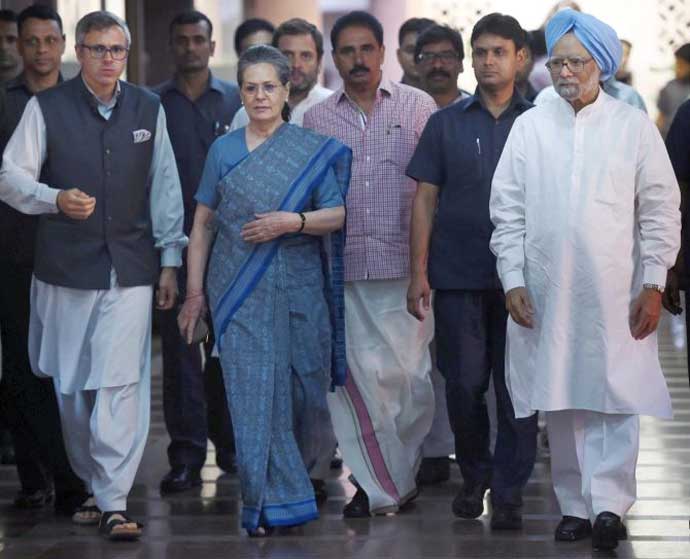Why Modi government desperately needs an Opposition

Democracy is dwarfed without a vibrant Opposition. Such an Opposition must fulfil three critieria.
One, it should be constructively adversarial to the government, not merely disruptive. Two, it must articulate cogent alternative polices to those the government is currently pursuing. And three, it must have the numbers to present voters with a real alternative at the next general election.
Last Friday (May 26), Congress President Sonia Gandhi hosted a lunch to stitch together an Opposition front. Here’s who attended: Lalu Prasad Yadav (RJD), Mamata Banerjee (TMC), Sharad Pawar (NCP), Mamata Banerjee (TMC), Sharad Pawar (NCP), Sitaram Yechury (Left), Deve Gowda (JDS), Sharad Yadav (JDU), Mayawati (BSP), Akhilesh Yadav (SP), Omar Abdullah (NC) and Kanimohzi (DMK).

A less impressive guest list would be difficult to invent. Several have criminal cases against them. That apart, they have neither cogent alternative policies nor the numbers to challenge the NDA in the 2019 Lok Sabha election.
That may be good news for the BJP-led NDA. It’s not good news for democracy. Without a strong, coherent Opposition, democracy is diminished.
Both policies and numbers matter.
Let’s look at the empirical possibility of a non-NDA government taking office after the 2019 Lok Sabha election. How do the numbers stack up for a national mahagathbandan that Sonia’s lunch was exploring?
Consider the total number of Lok Sabha seats the main attendees at Sonia’s lunch won in the 2014 Lok Sabha election:
| Congress | 45 |
| TMC | 34 |
| NCP | 6 |
| RJD | 4 |
| BSP | 0 |
| SP | 5 |
| Left Front | 9 |
| JD(S) | 2 |
| NC | 1 |
| DMK | 0 |
| Total | 106 |
What about the JD(U)?
Nitish Kumar’s lunch meeting with Prime Minister Narendra Modi one day after Sonia’s lunch may mean nothing – or everything.
The lunch was in honour of the visiting prime minister of Mauritius. Nitish skipped Sonia’s anti-NDA lunch on Friday (sending Sharad Yadav instead) but made time for a diplomatic engagement that hardly ranks as top-tier.
Nitish himself was typically coy: “If any chief minister meets the prime minister, you make a political interpretation. This (the apparently increasing closeness with former alliance partner BJP) is your interpretation, and it is far from the truth. Where is the comparison between the two meetings? One of them was a political meeting. I had already met honourable Soniaji on April 30 at her invitation. We had already discussed the issues of Opposition unity and the Presidential election. This (the Opposition meeting hosted by Sonia) was a lunch meeting and it was decided five days in advance that Sharad Yadavji will attend from our party. Today it was an invitation to a chief minister, not to the president of the JD(U). That (Friday’s invitation) was to the president of the party. Making a comparison between the two is misinterpretation.”
Nitish has also dismissed speculation of an imminent break-up with Lalu Prasad Yadav’s RJD in Bihar. But with Lalu fatally tainted by his association with co-convict Shahabuddin who has terrorist links, Nitish is finding it increasingly hard to hide his discomfort. The antics of Lalu’s two minister-sons are an added aggravation.

Even if a JD(U)-RJD split in Bihar is not imminent, it is unlikely Nitish will join a Congress-led anti-BJP front. His term as chief minister ends in 2020. A modus vivendi with Modi to increase central assistance to Bihar is a more attractive option than political suicide by allying with a Congress-led front.
In the 2014 Lok Sabha election, the UPA won just 60 seats. It is now hoping to beef up the numbers with regional parties. The biggest contribution to a UPA-led national mahagathbandan is Mamata Banerjee’s TMC. It already has 34 out of 42 seats in West Bengal. The headroom for further growth is therefore limited.
Other UPA partners and leaners like the NCP, SP, BSP, the Left and RJD are in poor electoral shape. The 10 main attendees at Sonia’s lunch might be hard pressed to match their collective 2014 tally of 106 parliamentary seats reflected in our chart above.
What about the fence-sitters? The BJD and YSR Congress lean towards the BJP. Jaganmohan Reddy’s YSR Congress has publicly announced support for the BJP’s presidential candidate – whoever he or she may be. The BJD may follow suit.
The TRS is trickier but will probably hew to a neutral line. Other UPA leaners like Ajit Singh’s RLD and Assaduddin Owaisi’s AIMIM are too small to matter.
Grim truth
Beyond the sagging numbers lies a grimmer truth: the lack of coherent policies. A putative UPA mahagathbandhan has parties with sharply conflicting ideologies and vote banks: TMC and the Left; BSP and SP.
The Congress, as leader of this inchoate pack, has not articulated coherent policies except to excoriate the BJP – which as the principal Opposition it is entitled to do.
But neither Sonia nor Rahul Gandhi has proposed a single constructive policy on economic, tax and labour reforms, tackling China’s bellicosity, neutralising Pakistan’s proxy terror war, fighting Maoism and improving law and order.
A responsible Opposition party should have constructed a shadow cabinet immediately after the May 2014 general election. Every shadow minister – from home and defence to external affairs and environment – should be proposing domain-specific policies on a regular basis instead of disruptive, ad hoc criticism.
The failure to do this belongs to the Gandhis. They have exhibited mediocre leadership. Most of their former ministers are busy in the Supreme Court fighting lucrative private cases instead of constructing specific policies within a shadow cabinet framework.
Just as democracy needs a good government, it equally needs a good Opposition. India’s Opposition has two years to redeem itself.

